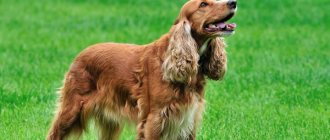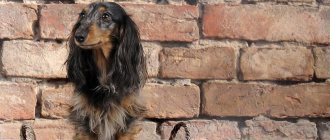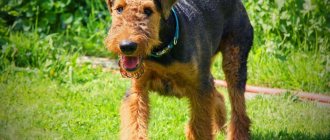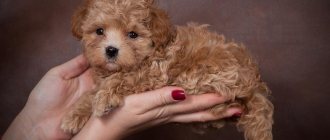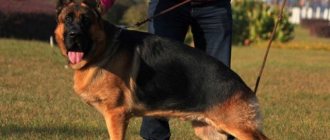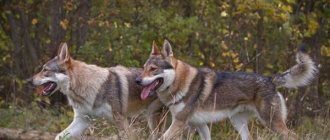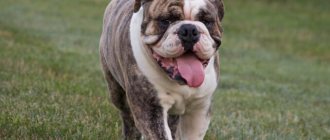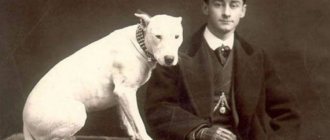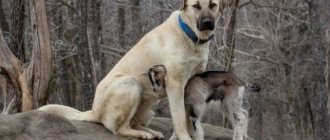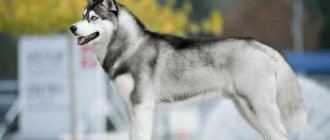In this article we will tell you about the most popular breeds of cop dogs, among which you will find the one that is right for you.
This subspecies of pets has the following qualities:
- loyalty;
- obedience;
- endurance;
- persistence;
- savvy;
- ease of training and training;
- aggression towards prey.
It is interesting to know that pointing dog breeds are not only the best hunters, but also good family protectors. Therefore, with proper training, they can be used to protect homes.
Features and types of cops
Pointing dogs are usually of medium height and have a strong build with little fat. They most often have soft and floppy ears. These breeds are in great demand among hunters, and the dogs can also make excellent companions.
Traditionally, all breeds of pointing dogs are divided into two large groups:
- island
- continental
Due to the popularity of gun hunting among the European nobility in the Middle Ages and Modern times, each country on this continent developed its own breeds of cops. There are especially many of them in Germany and France.
German Drahthaar (German Wirehaired Pointer)
- Height: from 57 to 68 cm
- Weight: from 27 to 32 kg
- Life expectancy: 12-14 years
- Personality: willful, affectionate, friendly, intelligent, loyal, active
The German Wirehaired Pointer is a strongly built dog that can move all day long over a variety of terrain. The weather-resistant, straight, coarse coat is an important characteristic of the breed. The undercoat is dense in winter, but thin in summer. The fur is water-repellent . The outer layer of fur is 2.5 to 5 cm long. The eyebrows, beard and sideburns are of medium length. By the way, here are some more cute dogs with beards.
As game hunting became accessible to middle-income people, the demand for specialized and versatile hunting breeds increased dramatically. The development of versatile breeds reached its peak in Germany, with the German Wirehaired Pointer being one of the most successful results. It could locate and point out upland game, bring waterfowl to land, and act as a companion. For hunting in dense thickets, they were helped by coarse, hard wool.
Did you know that the most important ancestor of the German Drahthaar was the Poodlepointer, which was crossed with early German Shorthaired Pointers, Griffons, Stichelhaars and Polish Water Dogs. The breed was not officially recognized until the 1920s.
The German Wirehaired Pointer can be a tough sporting dog or a friendly companion. He has enough energy to walk for hours. This is a responsive breed , although some can be quite stubborn.
The Drahthaar has an excellent protective instinct, so it can be aloof towards strangers and strange dogs. He is generally good with children, although he is sometimes overly noisy. It is ideal for those who love outdoor recreation and want to have a tireless and intelligent pet.
Exercise is a daily requirement for this energetic dog. It is recommended to exercise for at least an hour a day, and ideally it would be a combination of exercise with walking or the opportunity to run and explore the surrounding area.
Ariège braque
This relatively young breed of cops was bred at the turn of the 19th and 20th centuries. Its homeland is the region of the same name, located in the foothills of southern France.
The Ariège Braque is a fairly tall dog, reaching 56-67 cm at the withers and weighing about 25-30 kg. On an elongated, proportional head with a slightly pronounced stop, there are oval dark eyes and hanging, close-fitting ears. The harmoniously developed body with a straight topline, strong neck and deep chest is covered with short, smooth hair of brown or pale orange-fawn color. The standard also allows for the existence of white individuals with chocolate markings.
The Ariège Braque is a reserved, balanced and very obedient dog. He does not show causeless aggression, but is quite restrained towards strangers. He easily gets along with his relatives and has excellent hunting qualities.
Story
All cops have ancestors of the ancient dogs of Europe, with which man has hunted birds since ancient times. An ancient dog, having found prey, lay down next to it, hence the name of the group of breeds - “coping dog”.
Initially, pointing dogs that appeared in Spain had long hair, but over time they became short-haired. Then they stopped lying down and began to make a beautiful stand.
Gradually, continental cops learned to bring game to the feet of the owner (port) from land and from water, stand on the hare, follow the trail, etc., and became even more in demand among hunters.
Groups of hunting dogs
Which dogs are better at hunting? In fact, the types of hunting breeds are diverse and include not only greyhounds and hounds, as some believe. All dogs that are suitable for catching prey are divided into 6 main groups. A person’s success in pursuing game largely depends on the right choice.
Greyhounds
These are quite large dogs, very strong, and can easily bear loads. They have sharp eyesight and high running speed. Pets are suitable for catching foxes, small ungulates, and hares. The tactics for catching an animal are as follows: upon seeing it, the dog develops high speed, catches up, and strangles the animal. Dogs can be used in open areas, in forests, forest-steppes, but their sense of smell is not very sensitive.
Hounds
These beautiful short-haired dogs, bred specifically for hunting, are designed to catch hares, foxes, and wild boars. They have an excellent sense of smell, persistence in pursuing game, and great vitality. The description of the breeds is as follows: large animals with hanging long ears, brown coat color with large white and black spots.
Hunting with hounds goes like this: the pet finds the animal by smell, barks loudly and runs after it, driving it towards the owner. A person shoots from cover when the position is comfortable. These dogs do not kill game, they are very friendly, adore children, and do not harm other pets.
Burrows
These dogs are small, active, and are used to catch animals in burrows. They climb straight into the hole, chase the fox and badger out of the second exit towards the hunter. A dog can also pull an animal out of a hole with its teeth. In addition to burrowing animals, such pets are capable of hunting birds and hares. They have one minus - they do not get along with other animals in the apartment.
Likes
Laikas are considered universal and the most popular dogs in the “hunting top”. They can be chosen to catch any bird, fur-bearing animals, ungulates and even bears. They have an excellent sense of smell, endurance, and speed are also excellent. Likes, despite the name, are far from noisy. They chase the game, silently, having caught up, they do not allow them to come to their senses and run away with loud barking and driving, biting. Laikas kill ducks themselves and bring them to the owner. As a guard dog, huskies lose: they are too friendly.
Cops
These purebred animals serve as gun animals - at the moment of the shot they are next to the person, “under the gun.” Cops are hardy, patient, and have excellent instincts. Dogs are best suited for catching birds. Smelling it, the dog sneaks up, comes close and takes a stance, which is the “calling card” of the breed. The man gives the command to throw, the bird takes off, and a shot is heard. Afterwards, the cops help find the killed game in the swamp, on the water meadow.
Spaniels and retrievers
Some of these dogs in Russia work as service dogs. They are of medium size, have a good disposition, and an easy-going character. Dogs love water, which is why they are often used to hunt waterfowl. Animals are even able to dive after a duck that has gone under water. A distinctive feature is the absence of damage to game by the dog due to its careful attitude. The hunting instincts of such dogs are very high, but they get tired quickly and cannot run long distances.
Griffons
A group of breeds belonging to subsection 1.3.
French Wirehaired Pointer Griffon
The breed received its second name, the Korthals Griffon, thanks to its creator, who set the goal of getting the most intelligent and hardy of the cops. The basis was taken from the best representatives of the hunting type.
The dog turned out exactly as the breeders wanted - tall, light, agile, smart. But due to the high cost and strict control over breeding, the breed did not become widespread and today is quite rare in our country.
Distinctive features common to all breeds in the group
Greyhounds are distinguished by some characteristic features both in their hunting method and in appearance.
Exterior features common to the entire breed group of greyhounds:
- streamlined, aerodynamic body shape, allowing dogs to accelerate up to 50–60 km/h;
- long limbs, especially strong, powerful and muscular hind legs, large paws;
- lean and dry body, as a result of accelerated intense metabolism;
- an elegant, light head with an elongated narrow muzzle on a long, curved and high-set neck (an animal can effectively change its balance by tilting its head while running);
- a massive, deep, expanded chest, accommodating voluminous lungs and a resilient, strong, large heart, necessary for intense exercise.
When working, greyhounds are characterized by:
- Agility (quick increase in running speed) combined with endurance.
- Poorly developed independent search for animals.
- A wide field of view, thanks to which the dog pursues prey while following it with its eyes (sighted or sighted).
Advantages of pointing dogs
Cops are considered descendants of hound dog breeds. They are similar in appearance and behavior. They differ from them only in their extremely keen sense of smell and ability to stand in front of the game.
Here are the main character traits of cops:
- There is no aggression towards humans in almost all breeds
- They prefer to hunt independently rather than in a pack
- Have a labile, mobile nervous system
- Easily switch attention while hunting
- They have their own search style and hunting stance.
How to choose a puppy
- The best way to test the working genes of a breed is to go out into the field with breeding bitches and dogs to personally evaluate the quality and length of their pull. Accordingly, if in your environment there is a professional hunter who sells the offspring of his charges, try to go out with him and his pets for game.
- The presence of a field diploma in a female and male English Pointer does not guarantee hunting feats in the offspring. If the achievements of the puppies’ parents are extremely important, give preference to cops who have passed not Russian, but international field tests. According to breeders, domestic pointer competitions do not reveal the hunting skills of dogs, but only confirm that they have a hunting instinct and readiness to work.
- You can test puppies for courage and mental balance by simply lifting them by the withers above the floor. If the baby squeals, struggles, and after being put on his feet, moves away or stands indecisively, this indicates a weak nature, as well as excessive timidity.
- English pointers, like all pointers, are quite affectionate, but for hunting you should not choose a sycophantic puppy that endlessly rubs against the breeder’s legs, looking into the eyes. It is much easier to train such individuals, but their effectiveness in field work is low.
- Consider the puppies' temperament type. Phlegmatic pointers have a sluggish move and are guilty of a short search. Individuals of the choleric type are more energetic and quicker, but sometimes they practice unsystematic search and mating of birds, and they are not always obedient.
Breton epañol
Or, as it is also called, the Epagnole Breton is an active, hard-working breed whose representatives can work in any weather. Epagnoles are unsurpassed hunters of partridge, pheasant and wild duck. They listen to their owner unquestioningly and can pursue the victim for a long time.
It will be useful for you to know: what are the reasons for licking dogs' paws, how to choose toys and harnesses, how to make a booth and enclosure with your own hands, what is inbreeding, trimming and grooming of dogs.
Representatives of this breed are distinguished by their playful character, gracefulness and ease of upbringing (they are loyal, obedient and open).
Island Pointer Breeds
English Setter
English Setter
Height: 61-68 cm.
Weight: 20-25 kg.
Country of origin: UK.
The English Setter is a very beautiful and elegant breed of pointing dog, a direct descendant of the ancient hunting dogs of Europe, which were used to hunt with nets in the Middle Ages until the advent of the hunting rifle.
With the advent of firearms, English setters also improved for the better: they learned to run much faster and stand up more beautifully. Eduard Laverack played a major role in the formation of the breed and its standard.
It was thanks to him that a purebred English setter was born, which was named Laverack in honor of the father of the breed. This is a very aristocratic breed of dog with an elegant physique, calm and good-natured character.
Scottish Setter
Height: 62-66 cm.
Weight: about 29 kg.
Country of origin: UK.
This beautiful black and tan setter is the result of crossing English Setters and Pointers. The breed was formed and described in the mid-60s of the 19th century.
This is a very hardy dog that is capable of hunting in the most difficult terrain. He has an excellent sense of smell, but requires long and painstaking training. She can be kept in a city apartment, but needs constant walking.
The Scottish Setter requires periodic brushing and bathing. He constantly requires the attention of his owner and family, he is a wonderful companion and a wonderful friend. It cannot be alone, sitting on a chain as a watchman.
English pointer
Height: 61-69 cm.
Weight: 20-34 kg.
Country of origin: UK.
This is a fairly large setter, in which the blood of a foxhound, bulldog and even a greyhound flows. The first standard of the breed was formed only at the end of the 19th century, although it has been bred for at least two hundred years.
The breed is divided into light and heavy types. Even in the second case, this is a slender and graceful dog with very great dignity. By character, like all Englishmen, she is a phlegmatic person in a calm state, and a real choleric person in an excited state.
The English Pointer has an excellent nose, he is a natural hunter, and therefore constantly needs walks in fields and forests. The dog has the ability to search widely and has an excellent strong stance.
Irish Red Setter
Irish Setter
Height: 55-67 cm.
Weight: 27-32 kg.
Country of origin: Ireland.
These setters come from Ireland and developed as a separate breed in the mid-19th century. The Irish Setter appeared in Russia a long time ago, but it is difficult to train due to its proud nature.
It is worth noting that Russian dog handlers and breeders became interested in these pointers and developed their own improved breed of Irish setters. As a result, it became much easier to communicate and get along with them.
This is a very beautiful and elegant dog with a high stance. It can be used in summer and autumn for hunting in the steppe, swamps and forests. With proper upbringing, it demonstrates miracles of training.
Irish Red and White Setter
Height: 57-66 cm.
Weight: 15-30 kg.
Country of origin: Ireland.
This is another popular Irish pointer specializing in hunting game birds. She simply loves hunting and needs a large rural space and regular exercise.
This setter is completely tireless in searching for game, has a beautiful stance, and an innate ability to fetch. A good bird hunter simply cannot find a better assistant. The Irishman is not aggressive towards people and pets.
If you just need a companion, then this dog is very friendly and good-natured, and will quickly find a common language with children. Just don’t forget to walk her through the forests and fields longer, otherwise she may become sad and get sick.
German Shorthaired Pointer (German Shorthaired Pointer)
- Height: from 53 to 64 cm
- Weight: from 20 to 32 kg
- Life expectancy: 12-14 years
- Personality: affectionate, intelligent, lively, courageous, easy to train
The German Shorthaired Pointer is a versatile dog that works closely with people, combining agility, strength and endurance. The shorthaired pointer has the ability to point, track and retrieve prey. He has graceful lines, strong bones and an athletic build. The coat is short and harsh.
This hunting breed arose due to the deliberate mixing of various breeds, which began in the seventeenth century . First, they crossed the Spanish Pointer with the Hanoverian Hound, later adding the genes of English Pointers. The breed was recognized in the late 1800s. The breed soon gained a reputation as the ideal dog for hunters who wanted just one dog that could do it all.
IMPORTANT! The German Shorthaired Pointer's idea of heaven is a daytime walk and an evening relaxation next to its owner. This is an active dog that can become "creative" if it is not given enough daily mental and physical exercise.
The German shorthaired pointer is a loyal family pet , although at times it can be overly noisy with small children. Since part of their heritage includes hunting mammals, some can be assertive towards small pets if they have not been raised with them. This is a sensitive breed that responds to gentle training. Some may whine or bark a lot.
Bred to be an active hunting companion, this breed has a lot of energy and requires a lot of exercise. Many Shorthaired Pointers love water and will happily swim if given the opportunity. Maintenance needs are minimal and consist only of occasional brushing.
Weimaraner
The homeland of this pointing dog breed, the photograph of which is posted just below, is a small town located 25 km from Erfurt. Its breeding was carried out by noble people who solved important state issues. The breed received official recognition in 1897.
The Weimaraner is a tall, dry dog whose height is 59-69 cm at the withers. The harmonious, sculpted head with a pronounced nape and elongated muzzle has slanting yellow or isabella eyes and high-set drooping ears. The long, athletic body with a deep chest and sloping croup is covered with long or short hair of silver-gray, mouse or roe color.
The Weimaraner is a sociable, good-natured and playful dog with a well-expressed hunting instinct. He gets along well with children and is quite trainable. As for hunting, such a dog demonstrates the most effective work in flat and wooded areas.
B
Basenji
These are true companions for humans, as they easily and quickly become attached to their owner and the rest of the family.
Basset Hound
This is a dog with enormous intellectual capabilities, but at the same time loves to be loved and respected. They have a very calm disposition and do not require serious physical exertion.
Bedlington Terrier
It has a unique appearance, but at the same time the dog is distinguished by the presence of pronounced hunting instincts, while possessing a sense of self-esteem.
White Swiss Shepherd
A guard dog breed, therefore, it has all the characteristics inherent in this function. Does not show aggression towards strangers and animals, including dogs.
Belgian Griffon
It is an indoor decorative breed, but is distinguished by its unique development with a change in character. When a dog is young, it is rather weak and inactive. As an adult, she gains weight as well as muscle mass and subsequently becomes active and cheerful.
Belgian Shepherd
The dog is quite smart and has excellent security characteristics. She has a lively and intelligent look. However, it is not recommended for maintenance by inexperienced or indecisive owners.
Bernese Mountain Dog
This dog has many positive characteristics. This is not only a strong and hardy breed, it is very devoted to its owner and has a good-natured disposition.
Biewer Yorkshire Terrier
A decorative dog breed with a balanced temperament, but at the same time with a strong and strong-willed character. Feels great in the home company of people and animals.
Beagle
At one time, the breed of dogs helped people hunt small but nimble animals. The dog is friendly, smart, affectionate and energetic.
Bichon Frize
This is a naturally cheerful and playful dog. In addition, she is brave and non-aggressive, but at the same time she has a complex disposition that requires education and training.
Bloodhound
This is a true hound breed, extremely active, requiring constant physical activity. Otherwise, he will be able to turn the apartment into a trash bin.
Bobtail
Bobtails, despite their (comparatively) intimidating appearance, are distinguished by their friendly nature and loyalty towards family members.
Bolognese
The appearance of this breed is very attractive and interesting. They love their owners, but are distrustful of strangers.
Border Collie
The breed is an extremely energetic and fast-moving animal, and therefore requires constant physical activity.
Dogue de Bordeaux
A fairly ancient French breed, the ancestors of which are Roman fighting dogs. This breed was originally used to protect human settlements from wolves and bears.
You can't tell by its appearance that this dog has a very friendly character.
Beauceron
The breed is distinguished by the fact that it is quite social, since it is distinguished by its friendliness, both to its relatives and to other animals. The intelligence of this dog is at a high level.
Boston Terrier
This is a dog that has absorbed a lot of both positive and negative qualities. Needs qualified education and training.
Brazilian Fila
Can successfully protect an object that a person has entrusted to him. Shows distrust of strangers and even at exhibitions keeps everyone at a distance, including judges.
Brussels Griffon
Despite its small size, the breed knows its worth, but at the same time they show friendly feelings and love to play.
Bullmastiff
The breed is distinguished by boundless devotion to its owner, but at the same time they behave non-aggressively towards family members, acquaintances and friends, and are wary when meeting strangers.
Bull Terrier
A rather capricious and stubborn dog, therefore it requires a qualified approach to training and education. In addition, bull terriers must be constantly monitored, otherwise they will try to independently expand the boundaries of what is permitted.
Boerboel
These are strong and hardy dogs, with a beautifully built body that requires constant physical activity. For them, daily walks of 5 km are the minimum load.
Continental Pointer Breeds
German Shorthaired Pointer
German Shorthaired
Pointer Height: 58-66 cm.
Weight: 20-32 kg.
Country of origin: Germany.
This is a German shorthaired pointer, bred in Germany from older German breeds of pointers that previously hunted birds with nets. Later they became more versatile and learned to hunt with a gun.
Today, this popular breed continues to be improved by breeders; the dogs are able to carry out all hunting commands even in old age. The color can be very different: from deep black to coffee with many spots.
The shorthaired pointer can hunt birds and small animals. He does best hunting in the field, he swims beautifully even in icy water, brings game to the feet of his owner, follows a trail of blood, etc.
German drathaar
Height: 57-68 cm.
Weight: 23-32 kg.
Country of origin: Germany.
This breed of pointing dog was bred in Germany at the end of the 19th century. She is of medium height and brown in color with spots. The drathaar's tail is usually docked if the dog is to be used for hunting.
The breed is very popular among hunters all over the world. She perfectly hunts not only birds, but even wild boars, taking a stance or barking at the animal if necessary.
The hard coat protects the drathaar from the cold and insects. In search of a shot bird, it swims beautifully even in cold waters. Never shows any aggression towards people, good friend.
Hungarian Vizsla
Hungarian Vizsla
Height: 54-64 cm.
Weight: 20-27 kg.
Country of origin: Hungary.
This Hungarian pointer is considered one of the smartest and most talented dogs in the world. In addition, she has a very impressive appearance and an elegant gait. The ancestors of this dog appeared in the Carpathians in the 10th century with the nomadic Magyar tribes.
Their bright red or gold color attracted the Hungarian nobility. The dogs were their absolute favorites not only for their beauty, but also for their excellent hunting talents: a keen sense of smell, excellent stance, the ability to hunt anywhere, etc.
The Hungarian Vizsla is of average height and has a beautiful, muscular build. This is a very good-natured and friendly dog that shows virtually no aggression. He loves an active lifestyle and requires constant walks and exercise.
Italian bracque
Height: 55-67 cm.
Weight: 25-40 kg.
Country of origin: Italy.
This is an Italian pointer, which is used for hunting birds, although it is a universal hunter, it can also hunt rabbits. Italian breeders believe that the Braccus appeared in the 4th century and is descended from the Molossians.
Bracchi were extremely popular among the noble families of Italy during the Middle Ages. Back then, bird hunting was considered a sign of aristocracy. And at the end of the 19th century, these dogs almost disappeared. It took a long time to restore the breed.
The standard for the Italian cop appeared only in the middle of the 20th century, at which time it was officially recognized. This is a very strong and passionate dog that is simply eager to hunt. In between hunts, she can be a wonderful companion.
Weimar pointer
Weimar pointer
Weimar Pointer Weimar Pointer Height: 57-70 cm.
Weight: 30-40 kg.
Country of origin: Germany.
The ancestors of the Weimar pointer hunted big game hundreds of years ago. She has a high level of intelligence, is well trained and obeys her owner. This breed appeared, was recognized and registered at the end of the 19th century.
The Weimar Pointer is of medium to tall height and has a harmonious, muscular build. Color – antique silver. That is why the dog has the nickname “silver ghost” in Germany.
The Weimaraner is a very active dog that loves to learn and perfectly absorbs new material. She is mobile, active, and loves to always be ahead. The good-natured and gentle Weimar Pointer never shows aggression towards humans.
General information about breeds
The pointer is irreplaceable in any hunt and is called upon to perform a number of functions, both innate and developed through training. Pointer breeds can specialize separately in waterfowl and sushi game, or be generalists, exclusively hunters, or perform other useful functions.
The pointing dog not only has many common features with the hound, but also acquired its own characteristic features in the course of evolution. Its main properties as a hunting breed are:
- acute sense of smell;
- active search for game by the upper scent, with the head raised up;
- working on the lower scent, with the head down, is considered more typical for hounds, but pointers also use it if necessary;
- when “catching the scent” of a bird or animal, slow down the pace, carefully search for the purpose of detection;
- genetically inherent ability to freeze in a stance when detecting game;
- the ability to bring prey to the owner without damaging it.
Additional Information. A pointing dog is a quick-witted and attentive creature, capable of instantly orienting itself in space, with a lability of nervous system.
A cop, as a rule, is not capable of being a good guard, but in some cases he exhibits these qualities.
Spaniels
In the standard they belong to subsection 1.2
Epagnol
Breton (Breton) Epagnole is the result of working with English setters. The dog turned out to be a smaller and slightly modified version of its ancestor. This is a hunting gun pointing dog with developed intelligence and a cheerful disposition.
Then the breeders were inspired by the result of the work, and they bred several more breeds of Epagnoles, each of which was recognized:
- Pont-Odemer - a super-hunter and a merry fellow, who was nicknamed “the clown from the swamps”;
- Picardy - a dog with a very keen sense of smell;
- Blue Picardy is an excellent hunting and companion dog;
- The Frenchie is the most docile among hunting spaniels.
German langhaar
The breed is also called the German Longhaired Pointer, which appeared as a result of breeding work with French and German spaniels. Later, the blood of setters was added to the Langhaars, which made the representatives of the breed taller.
In our time, this type of pointer remains a hunting dog, which, having spent energy while working, becomes affectionate and obedient at home.
Rare, unrecognized cops of this group
These included large and small Munsterlanders, Drente Epagnoles, and Stabyhunes. But the widespread Russian hunting spaniel, unfortunately, has never received international recognition, although the dog is successfully used both at home and abroad.
Maintenance and care
Heat-loving and sociable pointers will be equally uncomfortable both in a street doghouse and in the cramped conditions of a city apartment. The optimal housing for a cop is a house with a large yard, where the dog will not be restricted in its movement and will be willing to let it in and out of the room. Some pointer breeders prefer to keep their charges in enclosures. This is not ideal, but it is acceptable provided that the enclosure and the booth located in it are insulated as much as possible. Remember, the pet’s habitat should not be located in a damp and dark corner, but it also should not be in direct sunlight.
It is unacceptable to keep an English Pointer on a leash - the dog must move freely around the territory of a fenced garden plot and house. At the same time, walking around the owner’s property does not cancel daily walks. Twice a day, the Pointer should take an hour and a half walk outside his own yard, regardless of the weather.
Hygiene
The working English Pointer is a problem-free dog in terms of hygiene needs. The hard, short coat of the Cop does not get dirty and does not require frequent washing, trimming and combing, so you can brush your pet’s body once or twice a week. True, if the animal lives in an apartment, you will have to accept as inevitable the hairs that fall out and “stick” to the soft upholstery, which do not want to be removed with a vacuum cleaner and broom.
Increased attention is paid to the condition of a working pointer after a hunt. Upon returning from the field, you need to examine the dog’s paws and body, treating any scratches with water and then with an antiseptic. It is also necessary to examine the eyes and remove debris from them. At the same time, you need to feel the pet’s fur and remove ticks from it, if any appear, although it is more correct to promptly treat the cops with anti-ectoparasite agents.
Advice: it is better not to try to unscrew the tick, but to lubricate it with oil or gasoline. After a few minutes, the blood-sucking insect will fall off on its own, and you will have the opportunity to treat the bite site with iodine.
If a dog does not hunt for a long time, its nails grow long and its paw pads become flattened. In this regard, before training and going out into the field, the claws must be shortened, and the overgrown hair between the toes must be trimmed, which will make the pet’s movements freer and eliminate the possibility of injury to the paws. Once a week, and also after a hunt, the Pointer's ears are checked, removing dirt and wax from them with a clean rag soaked in hygienic lotion from a veterinary pharmacy.
Feeding
As a true hunter, the English Pointer should be fed lean, sinewy meat, a variety of meat scraps, and offal. Sea fish, cut into fillets, low-fat cottage cheese and a chicken egg are introduced into the diet several times a week to satisfy the body's need for protein. The source of fat for pointers can be butter and vegetable oil, as well as beef fat. True, the latter product is suitable exclusively for healthy and active individuals.
The most popular dish among experienced pointer fishermen is meat porridge. It is boiled with rice and buckwheat cereals, adding pieces of carrots or pumpkin. Growing pets may benefit from calcium supplements selected by a veterinarian. The frequency of feeding pointers is the same as for other hunting breeds. Up to two months of age, puppies are fed up to 6 times a day, from two to four months - 5 times, from four to five months - 4 times, from five months to six months - 3 times, from six months - twice a day.
Some breeders do not feed pointers before a hunt, sincerely believing that on an empty stomach the pointer's senses are sharpened and it concentrates better on the process of tracking down prey. In fact, the dog’s nutrition at the height of the hunting season should be enhanced, otherwise the animal will have nowhere to draw energy from. True, in order to avoid intestinal volvulus, you need to treat your hunting pointer no later than 2 hours before leaving for the field, and it is better if it is not a heavy meal, but a small snack. The pointer is fed more thoroughly after the hunt - this is an old tradition that instills in the dog an understanding of the importance of the work process.
English pointer
Experienced hunters claim that this is the best dog in its category. Puppies show instincts at an early age. Pointers have an excellent sense of smell and can run for quite a long time in search of prey.
Puppies need to be raised from childhood, providing them with constant exercise. If such a dog lives in a home and is unable to release its energy, it may become uncontrollable. Pointers must spend a long time outdoors. In addition, they love to swim.
Education, training, coaching
Professional breeders assure that training a Pointer is no more difficult than training a Drahthaar. By the way, at first, cop hunters are raised and trained according to the same template as pets. Remember, if a dog is obedient and attentive in a home environment, it will behave similarly in a work environment. And vice versa - an untrained pointer will never become a patient hunter capable of getting at least some trophy.
The first stages of training a puppy are socialization and developing the habit of obeying a person. The child must unconditionally accept the authority of the owner, but not see him as a tyrant who generously “prescribes” punishments. In general, the style of communication with a Pointer should be restrained. It is equally impossible to both loosen up a pointer and push it into rigid boundaries, since this is not a service breed. The first commands that a future hunter must learn are: “Lie down!” (can be replaced with the command “Down!”), “No!”, “Forward!”. Usually it takes a lot of time and effort to master them, but since hunting without controls is impossible, you will have to try.
Many owners teach English Pointer puppies to fetch objects. This is a valid and useful skill for the upcoming hunt. However, it is important to understand that only puppies like to carry balls and tufts of feathers in their teeth. Over time, even among super-professional cops, interest in retrieving and serving game decreases, and it is not always possible to get it back. If a pointer willingly jumps into the swamp after a shot duck, you can consider yourself very lucky with your pet.
Before moving on to training, the cop undergoes preliminary training. At this stage, the puppy must be taught to walk at the foot, practice calling (obligatory coming when the owner calls), the ability to lie down when ordered from a distance and follow in the direction indicated by the hunter. The habit of following at the feet of the owner is practiced with the help of a leash on daily walks. Make the dog aware of the fact that you cannot pull the strap and pull ahead of the person. If the animal is not perfect, but obediently stays at your feet, use a treat to stimulate it. Cops love it when their successes are encouraged, and in the future they try to earn a delicacy in an honest way.
Executing the command “Lie down!” at a distance is the most difficult exercise, since it is practiced on the street, where there are a lot of distractions. At the same time, you need to teach the dog to move in a given direction. It is better to do this by combining the commands “Right!”, “Left!” with pointing hand gestures - then with their help it will be easier to teach the pointer to shuttle search. After the preparatory stage has been completed, you are allowed to move on to training, which is formed from three basic skills - stretching, standing and drawing.
The pointer's stretch is the ability to immediately identify the scent of a bird. The faster the dog does this, the more valuable its work. Much has been written about the spectacular stance of Pointers, so we can only add that ideally a short stretch should turn into a sculptural stance, which the breed develops on an instinctive level. The culmination of hunting with a pointer is the eyeliner. Having signaled the location of the game with its stand, the dog begins to approach it in order to scare it away before being shot. However, in some cases it is recommended to skip this step. For example, when there is a hunt for swamp chickens and corncrakes. These birds do not always rise to the wing and often prefer running on the ground to flight. As a result, instead of making a lead, the pointer tries to follow the scent of the prey, which contradicts the hunting characteristics of the breed.
An important point in training and coaching English Pointers is punishment. Experts recommend correcting abnormal behavior in puppies very gently until they are three months old. For example, if an animal is naughty and does not ask to go to the toilet, you can threaten it with your voice or lightly shake it by the scruff of the neck. Breeders offer to lightly but noticeably whip the presumptuous young individuals with a rod. True, it is necessary to carry out “execution” only in exceptional cases. For example, when a dog knows and understands a command, but refuses to carry it out of spite and stubbornness.
Beagle
Representatives of a wide variety of breeds are united under this general name:
- beagles;
- basset hounds;
- Serbian hounds;
- bloodhounds;
- dachshunds;
- English Foxhounds;
- Smaland hounds;
- Austrian hounds;
- black and tan coonhounds;
- harriers;
- large Vendean basset griffons;
- Otterhounds, etc.
Representatives of the breed are united by their hunting behavior - the dog uses its keen sense to find the scent of game and chases after it, barking. Until the victim is completely exhausted or until a human hunter joins the case. Certain breeds of hounds were bred to chase foxes, rabbits, birds and even small ungulates.
As pets, these animals are loyal, obedient, curious and playful. They are distinguished by great intelligence and are easy to train.
Beagle puppy:
English Setter
An affectionate, friendly and self-possessed dog with a well-developed natural instinct and feline grace. The ideal bird hunter.
He gets along freely with other pets and feels great in the company of people. He is quite loyal to children, so he becomes a real family friend.
This breed, which originated in England, is characterized by the following external characteristics:
- smart look;
- muscular torso;
- drooping ears;
- short, thick and shiny coat;
- saber-shaped tail.
The main color of setters is white with black, brown or red patches. Did you know? Setters have long been respected. Their descriptions are found in the works of famous authors, and their images can often be found in paintings by great artists.
Animal care
Pay attention to caring for your ears and coat. Be sure to inspect your fur for ticks after going into the forest or hunting.
Check for damage or wounds.
After each hunt, comb the animal’s fur with special brushes, and if the pet is dirty, wipe the fur with a damp cloth or bathe the dog under running water or using animal shampoos.
When deciding to get a hunting dog breed if you have other pets in the house, remember that dogs can perceive them as prey, given their highly developed hunting instinct, so they can harm birds or rodents.
Cats will suffer no less. It is better to keep them separate from other pets, or at least isolate them in separate rooms while you are away.
Every owner must remember that proper feeding and care of the dog are the main factors for maintaining its health and general physical condition!
Boykin Spaniel
A type of spaniel specially bred for hunting in swamps - wild ducks and turkeys. These are highly trainable animals, brave and purposeful hunters. Their small size helps Boykin Spaniels move quickly through sticky terrain and chase waterfowl:
- Boys. Height – 40-45 cm, weight – 15-18 kg.
- Girls. Height 37-42 cm, weight 11-16 kg.
The life expectancy of representatives of the breed is 14-16 years. As pets, they are noted as friendly, energetic, sociable and intelligent creatures. The only thing is that their luxurious fur requires proper care.
Health and life expectancy
Drathaars are very well built physically and genetically, they have good health and a small list of diseases to which they are most predisposed:
- Hip dysplasia;
- Diabetes;
- Hypothyroidism;
- Otitis;
- Interdigital dermatitis;
- Bloating of the abdomen and intestines;
- Eye diseases (entropion, cataracts, progressive retinal atrophy);
- Cranial cruciate ligament rupture;
- Melanoma;
- Aortic stenosis;
- Mast cell cancer.
Drathaars are very hardy and quickly adapt to different conditions. However, prevention is just as important for them as for any other breed. Be sure to carry out annual vaccinations and regularly treat your dog against external and internal parasites.
In spring and autumn, attention is paid to protection against ticks, carriers of piroplasmosis. The average lifespan of a drathaar is 12-13 years.
Hungarian Vizsla
A large, muscular dog of an aristocratic appearance. It is a universal hunting dog - it works well both in the forest and in meadows. Well suited for hunting on terrain and in extreme weather conditions.
The Vizsla has a calm disposition and makes a wonderful friend. She shows friendliness to all family members. However, with her affectionate attitude, she shows constant vigilance towards strangers and ill-wishers.
If a Vizsla was raised with cats, it will tolerate all felines. Representatives of this breed are easy to train, but do not have an aggressive and persistent attitude.
Basic moments
- The breed is registered by the RKF, but has not received recognition from the International Canine Federation. In 2002, for the convenience of foreign breeders, the Russian Spaniel Club (USA) was created, which registers litters abroad.
- Despite their hunting qualifications and lively temperament, Russian spaniels easily adapt to city life and happily make forays into nature in their owner’s backpack.
- Breeding of the breed is carried out under the strict control of Russian breeding clubs, so most hereditary diseases have bypassed its representatives.
- Weather conditions do not affect the hunting talents of the Russian Spaniel. This dog can work perfectly in complete calm and even in hot weather.
- The Russian Hunting Spaniel is a born tracker and hunter. At the same time, he has a “non-aggression pact” with cats and other domestic animals with which the dog grew up.
- All representatives of the breed love to swim and are not afraid of cold water.
- A dog’s stomach is a “black hole” in which gigantic amounts of food disappear without a trace.
- Russian hunting spaniels are often involved in searching for psychotropic substances and detecting people in emergency situations. According to domestic dog handlers, this is one of the best breeds in terms of flair and search persistence.
- Taking a Russian hunting spaniel as a pet and companion is not prohibited, but it is very undesirable, since it is unlikely that it will be possible to provide the animal with the level of stress and emotions that working with game gives it.
The Russian hunting spaniel is a gambling “scout” with an easy-going character and an insatiable desire for games. Possessing an outstanding sense of smell and a strategic reserve of patience, this long-eared Stirlitz pursues prey to the last, so that hunting with him is always successful and rich in trophies. In ordinary life, Russian spaniels play the role of unpretentious modest people, but standard dog entertainment is also not alien to them. Another insatiable passion of the breed is food, so if you want to bribe your pet, show him a bowl of food. For such a “bribe” a Russian hunting spaniel will move mountains!

